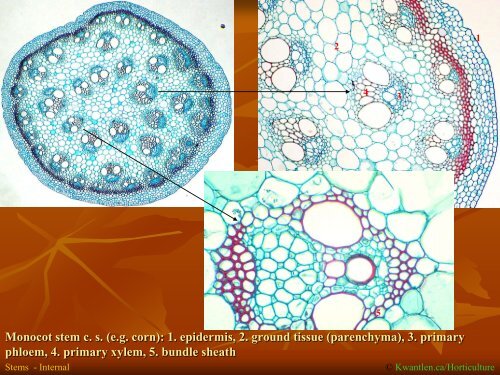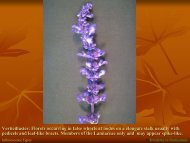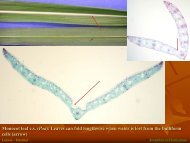Create successful ePaper yourself
Turn your PDF publications into a flip-book with our unique Google optimized e-Paper software.
Monocot stem c. s. (e.g. corn): 1. epidermis, 2. ground tissue (parenchyma), 3. primary<br />
phloem, 4. primary xylem, 5. bundle sheath<br />
<strong>Stems</strong> - <strong>Internal</strong> © Kwantlen.ca/Horticulture<br />
2<br />
4<br />
5<br />
3<br />
1
1<br />
2<br />
3 4 5<br />
Monocot stem c. s. (e.g. corn): 1. epidermis, 2. ground tissue (parenchyma), 3. primary<br />
phloem, 4. primary xylem, 5. bundle sheath<br />
<strong>Stems</strong> - <strong>Internal</strong> © Kwantlen.ca/Horticulture
Dicot stem tip l.s. (Coleus): 1. leaf primordium, 2. apical meristem, 3. protoderm (produces<br />
epidermis), 4. ground meristem (produces pith, cortex) 5. procambium (produces primary<br />
xylem, primary phloem), 6. petiole of new leaf, 7. bud primordium<br />
<strong>Stems</strong> - <strong>Internal</strong> © Kwantlen.ca/Horticulture<br />
1<br />
6 6<br />
3<br />
4<br />
4<br />
2<br />
7<br />
5
Young, dicot stem of alfalfa (Medicago sativa) c.s.: epidermis, cortex (parenchyma,<br />
collenchyma, vascular bundle (primary phloem, cambium, primary xylem), pith ray, pith<br />
<strong>Stems</strong> - <strong>Internal</strong> © Kwantlen.ca/Horticulture
A<br />
Herbaceous stem model: A = primary phloem; B = primary xylem; C= pith<br />
<strong>Stems</strong> - <strong>Internal</strong> © Kwantlen.ca/Horticulture<br />
B<br />
C
A<br />
B C<br />
Herbaceous stem model: A = epidermis; B = cortex; C= pith ray<br />
<strong>Stems</strong> - <strong>Internal</strong> © Kwantlen.ca/Horticulture
Monocot<br />
Comparison of young monocot and herbaceous dicot stem cross-sections: monocots have<br />
scattered vascular bundles and no secondary growth; dicots have a ring of separate<br />
vascular bundles that “grow together” and eventually have secondary growth<br />
<strong>Stems</strong> - <strong>Internal</strong> © Kwantlen.ca/Horticulture<br />
Dicot<br />
Primary growth<br />
secondary growth
A<br />
B<br />
Woody stem model: A = secondary phloem; B= vascular cambium; C= pith<br />
<strong>Stems</strong> - <strong>Internal</strong> © Kwantlen.ca/Horticulture<br />
C
A<br />
B C<br />
Woody stem model: A = Outer bark or periderm (cork cells, cork cambium, phelloderm or<br />
“live cork”; B = secondary phloem; C= secondary xylem (wood)<br />
<strong>Stems</strong> - <strong>Internal</strong> © Kwantlen.ca/Horticulture
vc<br />
Woody stem c.s.: cork cells, cork cambium, phelloderm, cortex, primary phloem, secondary<br />
phloem, vascular cambium, secondary xylem, primary xylem, pith<br />
<strong>Stems</strong> - <strong>Internal</strong> © Kwantlen.ca/Horticulture<br />
sx<br />
px<br />
p
Hardwood - secondary xylem of Angiosperms (e.g. oak): vessels, tracheids, ray cells,<br />
sclerenchyma fibers<br />
<strong>Stems</strong> - <strong>Internal</strong> © Kwantlen.ca/Horticulture
Softwood – secondary xylem of Gymnosperms (e.g. pine): tracheids, resin duct cells, ray<br />
cells<br />
<strong>Stems</strong> - <strong>Internal</strong> © Kwantlen.ca/Horticulture
Leaf Gap model: A = abscission zone; B = leaf trace; C= leaf gap<br />
<strong>Stems</strong> - <strong>Internal</strong> © Kwantlen.ca/Horticulture<br />
A<br />
B<br />
C




